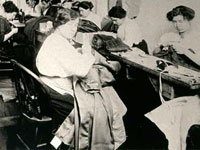The Gilded Age and the Progressive Era: The View from St. Augustine
This workshop will look at the Gilded Age (post-Reconstruction) and the Progressive Era as they affected and were seen by residents of St. Augustine.
This workshop will look at the Gilded Age (post-Reconstruction) and the Progressive Era as they affected and were seen by residents of St. Augustine.
This workshop will look at significant people and places in Florida during the Gilded Age -- that is, the late 1800s post-Reconstruction.
"From Miami's Little Havana to the immigrant world of West Tampa, from Immokalee farm worker centers to the cigar cities of Key West and Ybor City, Latinos have helped to shape Florida's cultural fabric. Examine the complexities of race, culture, ethnicity, identity, and nationality through a Latin lens. Probe the implications of the New Latino political movements, debates about immigrant rights, and the politics of diversity in our attempt to build a definition of what it means to be 'Floridian' in the new century."
This Pine Barrens village is composed of 33 historic buildings and structures including the Batsto Mansion, gristmill, sawmill, general store, workers' homes, and post office. Batsto Village was a former bog iron and glassmaking industrial center from 1766 to 1867 and currently reflects the agricultural and commercial enterprises that existed here during the late 19th century.
A second website, specifically for the Village, can be found here.
The site offers exhibits, tours, and occasional recreational and educational events.
The old Anaconda Copper Company smelter stack, completed in 1919, is one of the tallest free-standing brick structures in the world at 585 feet. The inside diameter is 75 feet at bottom, tapering to 60 feet at the top. In comparison, the Washington Monument is 555 feet tall. The stack dominates the landscape like the Company once dominated the area's economic life. Since the smelter closed in 1980, the stack has become a symbol of the challenges that face communities dependent on finite resources.
The site is open to the public.
Website does not specify any interpretive services beyond signage available at the site.
Today, the Southern New England Chapter (SNEC) of the Society for Industrial Archeology (SIA) keeps the industrial legacy of this region alive. Through its chapter newsletter, annual conference on New England industrial archeology and exclusive tours of industrial sites—most of them active, working factories otherwise inaccessible to the general public—the Society explores the places, lives, and ideas of the region's industrial heritage.
General interest organization for adults; does not seem to be focused on youth or school education.
Cannot find a working website; institution may no longer exist.
There is virtually no area of study that cannot shed light on the textile culture of North Carolina. Literature, music, science, economics, history, sociology, religion, and art help define and explain the rich history and changing culture of North Carolina textiles. Beginning in the 1880s, the textile industry built the "new south." Today, changes in this industry are helping to create another "new south." In this interdisciplinary seminar, participants will explore not only textile history but will also think about the role and importance of textiles. What the “product” was/is, how it is made and by whom, and where it is made have implications for the rapidly changing nature of textiles in North Carolina and the South.
The America's Industrial Revolution workshop at the Henry Ford will draw together K12 educators with leading humanities scholars and museum staff for unique enrichment exercises centered on the impact of industrialization. The workshop is designed to encourage participant curiosity and deepen knowledge on the subject, engage participants with innovative methods of transmitting enthusiasm and content to students, and empower participants to use cultural resources to enliven the teaching and learning of history. Participants will explore the diverse ways that Americans experienced social change between the 1760s and the 1920s through lecture/discussions and by visiting with museum curators at 12 of the 80 historic sites interpreted in Greenfield Village, including Thomas Edison's Menlo Park Laboratory, Hermitage Plantation Slave Quarters, 1760s Daggett Farm, 1880s Firestone Farm, a railroad roundhouse, and a 19th-century grist mill. In addition, time is set aside each day for exploration of archival sources in the Benson Ford Research Center and to work on individual lesson plans for implementation back home. The week's activities will culminate with a visit to a related National Historic Landmark, the Ford Motor Company's Rouge Industrial Complex.

On March 25, 1911, a fire broke out at the Triangle Shirtwaist Factory in New York City causing the deaths of 148 garment workers—an event that came to be known as one of the hallmark tragedies of the industrial age. This website tells the story of the fire in six chapters: Introduction; Sweatshops and Strikes; Fire; Mourning and Protest; Relief Work; and Investigation, Trial, and Reform.
The text, targeted to a middle and high school audience, is accompanied by numerous primary sources that could be of use to more advanced researchers. These include close to 70 photographs, 18 newspaper articles, 17 testimonials, three oral histories, excerpts from investigative reports written in the years following the fire, several letters from witnesses, a lecture given by Secretary of Labor Frances Perkins in 1964, and a radio drama reenacting the event. Accompanying these primary sources is a list of victims and witnesses, a selected bibliography of works surrounding the fire, and tips for writing a paper.